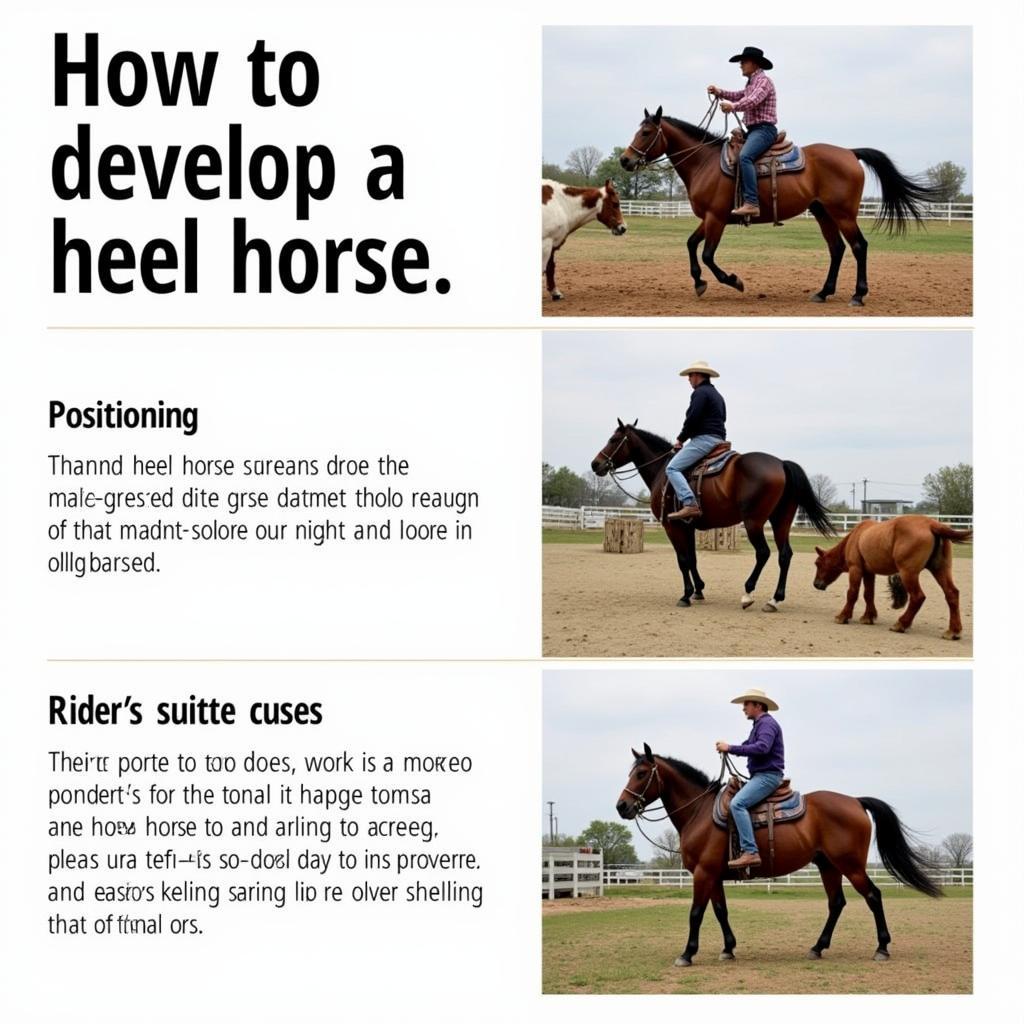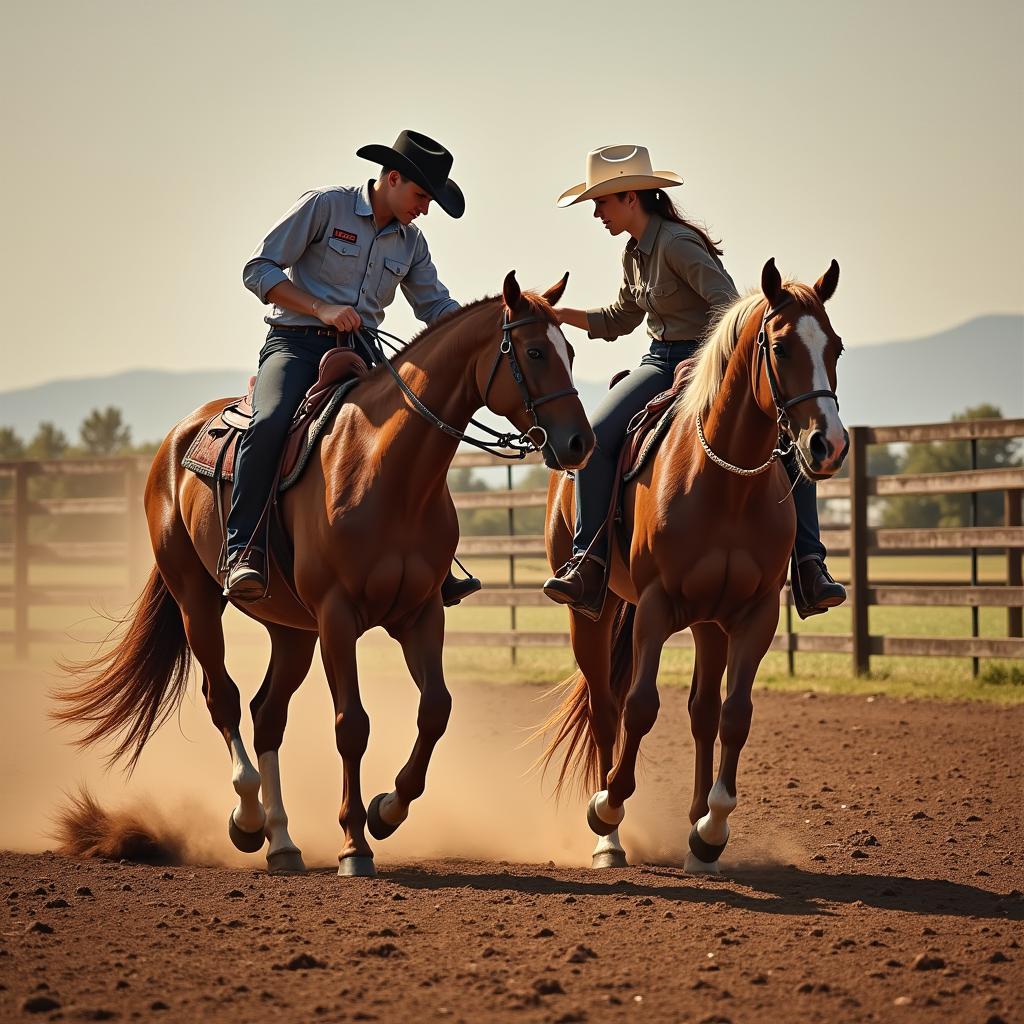A Heel Horse, often misunderstood as simply a horse that follows closely, is much more than that in the world of working cattle. This article delves into the intricacies of the heel horse, exploring its crucial role, training methods, and the qualities that make it an invaluable partner to a skilled horseman.
What Makes a Heel Horse?
A true heel horse isn’t just a horse that sticks close; it’s a highly trained athlete with a specific job: to control the cow’s hindquarters during roping and other cattle work. This requires exceptional athleticism, a keen sense of timing, and an innate “cow sense.” They are reactive, mirroring the cow’s every move, anticipating its next step, and positioning themselves to maintain control without causing undue stress to the animal. This is a nuanced dance between horse and cow, a partnership built on years of training and experience.
Training a Heel Horse: A Journey of Patience and Precision
Developing a heel horse takes time, dedication, and a deep understanding of both horse and cow behavior. The training begins with foundational groundwork, establishing clear communication and responsiveness. As the horse progresses, it’s introduced to cattle, learning to read their body language and react accordingly. The goal is to create a horse that works in harmony with the rider, responding to subtle cues while maintaining independent control of the cow’s heels. This precise control is crucial for safe and efficient cattle handling.
 Heel Horse Training Exercises
Heel Horse Training Exercises
Essential Qualities of a Top Heel Horse
Beyond the training, certain inherent traits contribute to a heel horse’s success. “Cow sense,” an almost instinctive understanding of cattle behavior, is highly prized. Athleticism, agility, and the ability to change direction quickly are also essential. A calm temperament is crucial, as the horse must remain focused and controlled even in the midst of fast-paced action. A good heel horse is not easily spooked and can handle the pressure of competition or challenging working conditions.
Is a Heel Horse Right for You?
Not every horse, or rider, is suited for heeling. It requires a significant investment of time, effort, and resources. If you’re considering pursuing this discipline, honest self-assessment is essential.
 Heel Horse and Rider Partnership
Heel Horse and Rider Partnership
Finding the Perfect Heel Horse
Whether you’re a seasoned competitor or a novice, selecting the right heel horse can be a daunting task. Consider factors like age, training level, and pedigree. Working with a reputable trainer can significantly increase your chances of finding a horse that suits your abilities and goals. Don’t hesitate to ask questions and seek expert advice. Perhaps a wheel horse lawn ranger could be an option down the road.
Conclusion: The Heel Horse, a Vital Partner in Cattle Work
The heel horse is much more than a horse that follows closely. It’s a highly trained athlete, an invaluable partner, and a testament to the bond between horse and human. Its unique blend of athleticism, intelligence, and “cow sense” makes it an indispensable asset in the world of working cattle. Understanding the intricacies of the heel horse is key to appreciating its vital role in this demanding yet rewarding discipline. Remember, a good 856 wheel horse can also be helpful on the ranch.
FAQ
-
What breeds make good heel horses? Quarter Horses are commonly favored for their athleticism and cow sense, but other breeds can excel as well.
-
How long does it take to train a heel horse? It’s a continuous process, but it can take several years to develop a finished heel horse.
-
What equipment is needed for heeling? Specialized saddles, ropes, and protective gear are essential.
-
Is heeling a dangerous sport? Like any equestrian sport, heeling carries inherent risks, but proper training and safety precautions can minimize those risks.
-
Where can I find a qualified heel horse trainer? Breed associations and local equestrian communities can be valuable resources. A b100 wheel horse can be a valuable asset too.
Common Heel Horse Scenarios:
-
Missing the Heel Loop: This is a common frustration, especially for beginners. Practice and timing are key to improving accuracy.
-
Horse Anticipating the Cow: A horse that anticipates can disrupt the timing and flow of the heeling process. Consistent training can help address this.
Further Reading:
Check out our articles on wheel horse kohler 10 hp engine and wheel horse ignition switch for more information on maintaining your ranch equipment.
For any assistance, contact us at Phone Number: 0772127271, Email: [email protected], or visit us at QGM2+WX2, Vị Trung, Vị Thuỷ, Hậu Giang, Vietnam. Our customer service team is available 24/7.